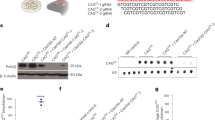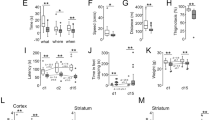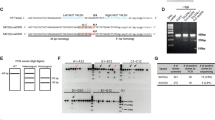Abstract
Current therapeutic strategies for Huntington’s disease (HD) are focused on symptom management of disease progression. Transcriptional dysregulation is one of the major characteristics in HD. REST is a transcriptional repressor that silences gene expression through binding to RE1/NRSE sites found in the regulatory regions of numerous neuronal genes. Dysregulation of REST and its targeted genes has been reported in different cell and mouse HD models, as well as in biopsies from human patients. In this work, we characterized transcriptional dysregulation associated with REST in two different HD mouse models and assessed the therapeutic effect of interfering with REST function by overexpressing a dominant-negative form (DN:REST). We show that delivery of DN:REST in the motor cortex restores brain-derived neurotrophic factor (BDNF) mRNA and protein levels by reducing endogenous REST occupancy at the Bdnf locus. Similarly, expression of other REST-regulated genes such as Synapsin I (Syn1), Proenkephalin (Penk1) and Cholinergic receptor muscarinic 4 (Chrm4) were restored to normal levels while non-REST-regulated genes were unaffected. This is the first study conducted to investigate REST’s role in vivo in a neurodegenerative disease. Our data show that DN:REST in motor cortex reversed RESTs repressive effects on target genes. However, the lack of therapeutic effect on motor function suggests that a more widespread rescue of REST-regulated sites in the affected brain regions may be necessary.
This is a preview of subscription content, access via your institution
Access options
Subscribe to this journal
Receive 12 print issues and online access
$259.00 per year
only $21.58 per issue
Buy this article
- Purchase on Springer Link
- Instant access to full article PDF
Prices may be subject to local taxes which are calculated during checkout





Similar content being viewed by others
References
Schoenherr CJ, Anderson DJ . The neuron-restrictive silencer factor (NRSF): a coordinate repressor of multiple neuron-specific genes. Science 1995; 267: 1360–1363.
Chong JA, Tapia-Ramírez J, Kim S, Toledo-Aral JJ, Zheng Y, Boutros MC, Altshuller YM, Frohman MA, Kraner SD, Mandel G . REST: a mammalian silencer protein that restricts sodium channel gene expression to neurons. Cell 1995; 80: 949–957.
Ooi L, Wood IC . Chromatin crosstalk in development and disease: lessons from REST. Nat Rev Genet 2007; 8: 544–554.
Kuwabara T, Hsieh J, Nakashima K, Taira K, Gage FH . A small modulatory dsRNA specifies the fate of adult neural stem cells. Cell 2004; 116: 779–793.
Palm K, Belluardo N, Metsis M, Timmusk T . Neuronal expression of zinc finger transcription factor REST/NRSF/XBR gene. J Neurosci 1998; 18: 1280–1296.
Bruce AW, Donaldson IJ, Wood IC, Yerbury SA, Sadowski MI, Chapman M et al. Genome-wide analysis of repressor element 1 silencing transcription factor/neuron-restrictive silencing factor (REST/NRSF) target genes. Proc Natl Acad Sci USA 2004; 101: 10458–10463.
Zuccato C, Cattaneo E . Role of brain-derived neurotrophic factor in Huntington's disease. Prog Neurobiol 2007; 81: 294–330.
Zuccato C, Tartari M, Crotti A, Goffredo D, Valenza M, Conti L et al. Huntingtin interacts with REST/NRSF to modulate the transcription of NRSE-controlled neuronal genes. Nat Genet 2003; 35: 76–83.
Cai L, Bian M, Liu M, Sheng Z, Suo H, Wang Z et al. Ethanol-induced neurodegeneration in NRSF/REST neuronal conditional knockout mice. Neuroscience 2011; 181: 196–205.
Johnson R, Gamblin RJ, Ooi L, Bruce AW, Donaldson IJ, Westhead DR et al. Identification of the REST regulon reveals extensive transposable element-mediated binding site duplication. Nucleic Acids Res 2006; 34: 3862–3877.
Johnson R, Teh CH, Kunarso G, Wong KY, Srinivasan G, Cooper ML et al. REST regulates distinct transcriptional networks in embryonic and neural stem cells. PLoS Biol 2008; 6: e256.
Johnson DS, Mortazavi A, Myers RM, Wold B . Genome-wide mapping of in vivo protein-DNA interactions. Science 2007; 316: 1497–1502.
Packer AN, Xing Y, Harper SQ, Jones L, Davidson BL . The bifunctional microRNA miR-9/miR-9* regulates REST and CoREST and is downregulated in Huntington’s disease. J Neurosci 2008; 28: 14341–14346.
Johnson R, Buckley NJ . Gene dysregulation in Huntington’s disease: REST, microRNAs and beyond. Neuromolecular Med 2009; 11: 183–199.
Bithell A, Johnson R, Buckley NJ . Transcriptional dysregulation of coding and non-coding genes in cellular models of Huntington's disease. Biochem Soc Trans 2009; 37 (Pt 6): 1270–1275.
Calderone A, Jover T, Noh KM, Tanaka H, Yokota H, Lin Y et al. Ischemic insults derepress the gene silencer REST in neurons destined to die. J Neurosci 2003; 23: 2112–2121.
Formisano L, Noh KM, Miyawaki T, Mashiko T, Bennett MV, Zukin RS . Ischemic insults promote epigenetic reprogramming of mu opioid receptor expression in hippocampal neurons. Proc Natl Acad Sci USA 2007; 104: 4170–4175.
Lawinger P, Venugopal R, Guo ZS, Immaneni A, Sengupta D, Lu W et al. The neuronal repressor REST/NRSF is an essential regulator in medulloblastoma cells. Nat Med 2000; 6: 826–831.
Fuller GN, Su X, Price RE, Cohen ZR, Lang FF, Sawaya R et al. Many human medulloblastoma tumors overexpress repressor element-1 silencing transcription (REST)/neuron-restrictive silencer factor, which can be functionally countered by REST-VP16. Mol Cancer Ther 2005; 4: 343–349.
Westbrook TF, Martin ES, Schlabach MR, Leng Y, Liang AC, Feng B et al. A genetic screen for candidate tumor suppressors identifies REST. Cell 2005; 121: 837–848.
Coulson JM . Transcriptional regulation: cancer, neurons and the REST. Curr Biol 2005; 15: R665–R668.
Lv H, Pan G, Zheng G, Wu X, Ren H, Liu Y et al. Expression and functions of the repressor element 1 (RE-1)-silencing transcription factor (REST) in breast cancer. J Cell Biochem 2010; 110: 968–974.
Bahn S, Mimmack M, Ryan M, Caldwell MA, Jauniaux E, Starkey M et al. Neuronal target genes of the neuron-restrictive silencer factor in neurospheres derived from fetuses with Down's syndrome: a gene expression study. Lancet 2002; 359: 310–315.
Canzonetta C, Mulligan C, Deutsch S, Ruf S, O’Doherty A, Lyle R et al. DYRK1A-dosage imbalance perturbs NRSF/REST levels, deregulating pluripotency and embryonic stem cell fate in Down syndrome. Am J Hum Genet 2008; 83: 388–400.
Lepagnol-Bestel AM, Zvara A, Maussion G, Quignon F, Ngimbous B, Ramoz N et al. DYRK1A interacts with the REST/NRSF-SWI/SNF chromatin remodelling complex to deregulate gene clusters involved in the neuronal phenotypic traits of Down syndrome. Hum Mol Genet 2009; 18: 1405–1414.
Kuwahara F, Kai H, Tokuda K, Niiyama H, Tahara N, Kusaba K et al. Roles of intercellular adhesion molecule-1 in hypertensive cardiac remodeling. Hypertension 2003; 41 (3 Pt 2): 819–823.
Majumder S . REST in good times and bad: roles in tumor suppressor and oncogenic activities. Cell Cycle 2006; 5: 1929–1935.
Bingham AJ, Ooi L, Kozera L, White E, Wood IC . The repressor element 1-silencing transcription factor regulates heart-specific gene expression using multiple chromatin-modifying complexes. Mol Cell Biol 2007; 27: 4082–4092.
Garriga-Canut M, Schoenike B, Qazi R, Bergendahl K, Daley TJ, Pfender RM et al. 2-Deoxy-D-glucose reduces epilepsy progression by NRSF-CtBP-dependent metabolic regulation of chromatin structure. Nat Neurosci 2006; 9: 1382–1387.
HDCRG. A novel gene containing a trinucleotide repeat that is expanded and unstable on Huntington’s disease chromosomes. Cell 1993; 72: 971–983.
Zuccato C, Valenza M, Cattaneo E . Molecular mechanisms and potential therapeutical targets in Huntington’s disease. Physiol Rev 2010; 90: 905–981.
Shimojo M . Huntingtin regulates RE1-silencing transcription factor/neuron-restrictive silencer factor (REST/NRSF) nuclear trafficking indirectly through a complex with REST/NRSF-interacting LIM domain protein (RILP) and dynactin p150 Glued. J Biol Chem 2008; 283: 34880–34886.
Zuccato C, Belyaev N, Conforti P, Ooi L, Tartari M, Papadimou E et al. Widespread disruption of repressor element-1 silencing transcription factor/neuron-restrictive silencer factor occupancy at its target genes in Huntington's disease. J Neurosci 2007; 27: 6972–6983.
Hodges A, Strand AD, Aragaki AK, Kuhn A, Sengstag T, Hughes G et al. Regional and cellular gene expression changes in human Huntington’s disease brain. Hum Mol Genet 2006; 15: 965–977.
Johnson R, Buckley NJ . Gene dysregulation in Huntington’s disease: REST, microRNAs and beyond. Neuromolecular Med 2009; 11: 183–199.
Marullo M, Valenza M, Mariotti C, Di Donato S, Cattaneo E, Zuccato C . Analysis of the repressor element-1 silencing transcription factor/neuron-restrictive silencer factor occupancy of non-neuronal genes in peripheral lymphocytes from patients with Huntington’s disease. Brain Pathol 2010; 20: 96–105.
Zuccato C, Cattaneo E . Brain-derived neurotrophic factor in neurodegenerative diseases. Nat Rev Neurol 2009; 5: 311–322.
Johnson R, Zuccato C, Belyaev ND, Guest DJ, Cattaneo E, Buckley NJ . A microRNA-based gene dysregulation pathway in Huntington's disease. Neurobiol Dis 2008; 29: 438–445.
Soldati C, Bithell A, Conforti P, Cattaneo E, Buckley NJ . Rescue of gene expression by modified REST decoy oligonucleotides in a cellular model of Huntington's disease. J Neurochem 2011; 116: 415–425.
Rigamonti D, Bolognini D, Mutti C, Zuccato C, Tartari M, Sola F et al. Loss of huntingtin function complemented by small molecules acting as repressor element 1/neuron restrictive silencer element silencer modulators. J Biol Chem 2007; 282: 24554–24562.
Leone S, Mutti C, Kazantsev A, Sturlese M, Moro S, Cattaneo E et al. SAR and QSAR study on 2-aminothiazole derivatives, modulators of transcriptional repression in Huntington's disease. Bioorg Med Chem 2008; 16: 5695–5703.
Gray M, Shirasaki DI, Cepeda C, Andre VM, Wilburn B, Lu XH et al. Full-length human mutant huntingtin with a stable polyglutamine repeat can elicit progressive and selective neuropathogenesis in BACHD mice. J Neurosci 2008; 28: 6182–6195.
Schilling G, Becher MW, Sharp AH, Jinnah HA, Duan K, Kotzuk JA et al. Intranuclear inclusions and neuritic aggregates in transgenic mice expressing a mutant N-terminal fragment of huntingtin. Hum Mol Genet 1999; 8: 397–407.
Aid T, Kazantseva A, Piirsoo M, Palm K, Timmusk T . Mouse and rat BDNF gene structure and expression revisited. J Neurosci Res 2007; 85: 525–535.
Valenza M, Cattaneo E . Emerging roles for cholesterol in Huntington's disease. Trends Neurosci 2011; 34: 474–486.
Sardiello M, Palmieri M, di Ronza A, Medina DL, Valenza M, Gennarino VA et al. A gene network regulating lysosomal biogenesis and function. Science 2009; 325: 473–477.
The BSG. A controlled trial of recombinant methionyl human BDNF in ALS: The BDNF Study Group (Phase III). Neurology 1999; 52: 1427–1433.
Timmusk T, Palm K, Lendahl U, Metsis M . Brain-derived neurotrophic factor expression in vivo is under the control of neuron-restrictive silencer element. J Biol Chem 1999; 274: 1078–1084.
Boudreau RL, McBride JL, Martins I, Shen S, Xing Y, Carter BJ et al. Nonallele-specific silencing of mutant and wild-type huntingtin demonstrates therapeutic efficacy in Huntington’s disease mice. Mol Ther 2009; 17: 1053–1063.
Simonelli F, Maguire AM, Testa F, Pierce EA, Mingozzi F, Bennicelli JL et al. Gene therapy for Leber's congenital amaurosis is safe and effective through 1.5 years after vector administration. Mol Ther 2010; 18: 643–650.
Ashtari M, Cyckowski LL, Monroe JF, Marshall KA, Chung DC, Auricchio A et al. The human visual cortex responds to gene therapy-mediated recovery of retinal function. J Clin Invest 2011; 121: 2160–2168.
Christine CW, Starr PA, Larson PS, Eberling JL, Jagust WJ, Hawkins RA et al. Safety and tolerability of putaminal AADC gene therapy for Parkinson disease. Neurology 2009; 73: 1662–1669.
Kaplitt MG, Feigin A, Tang C, Fitzsimons HL, Mattis P, Lawlor PA et al. Safety and tolerability of gene therapy with an adeno-associated virus (AAV) borne GAD gene for Parkinson's disease: an open label, phase I trial. Lancet 2007; 369: 2097–2105.
Bankiewicz KS, Forsayeth J, Eberling JL, Sanchez-Pernaute R, Pivirotto P, Bringas J et al. Long-term clinical improvement in MPTP-lesioned primates after gene therapy with AAV-hAADC. Mol Ther 2006; 14: 564–570.
Liu G, Martins I, Wemmie JA, Chiorini JA, Davidson BL . Functional correction of CNS phenotypes in a lysosomal storage disease model using adeno-associated virus type 4 vectors. J Neurosci 2005; 25: 9321–9327.
Conforti P, Camnasio S, Mutti C, Valenza M, Thompson M, Fossale E et al. Lack of huntingtin promotes neural stem cells differentiation into glial cells while neurons expressing huntingtin with expanded polyglutamine tracts undergo cell death. Neurobiol. Dis 2012, e-pub ahead of print 23 October 2012; doi:10.1016/j.nbd.2012.10.015.
Acknowledgements
This research was supported by CHDI Foundation (NY, USA) to EC, NB and BD, by Ministero dell’Istruzione dell’Università e della Ricerca (MIUR, 2008 JKSHKN) and, partially, by Fondazione Cariplo (Italy) to EC and the Roy J Carver Trust to BD.
Author information
Authors and Affiliations
Corresponding author
Ethics declarations
Competing interests
The authors declare no conflict of interest.
Additional information
Supplementary Information accompanies the paper on Gene Therapy website
Supplementary information
Rights and permissions
About this article
Cite this article
Conforti, P., Mas Monteys, A., Zuccato, C. et al. In vivo delivery of DN:REST improves transcriptional changes of REST-regulated genes in HD mice. Gene Ther 20, 678–685 (2013). https://doi.org/10.1038/gt.2012.84
Received:
Revised:
Accepted:
Published:
Issue Date:
DOI: https://doi.org/10.1038/gt.2012.84
Keywords
This article is cited by
-
REST in the Road Map of Brain Development
Cellular and Molecular Neurobiology (2023)
-
Zebrafish an experimental model of Huntington’s disease: molecular aspects, therapeutic targets and current challenges
Molecular Biology Reports (2021)
-
The emerging field of epigenetics in neurodegeneration and neuroprotection
Nature Reviews Neuroscience (2017)



